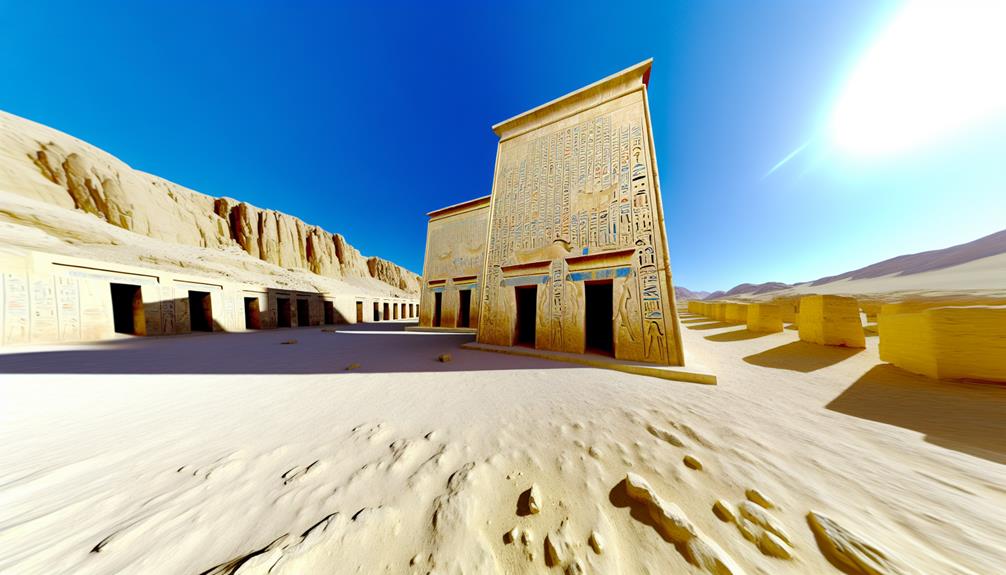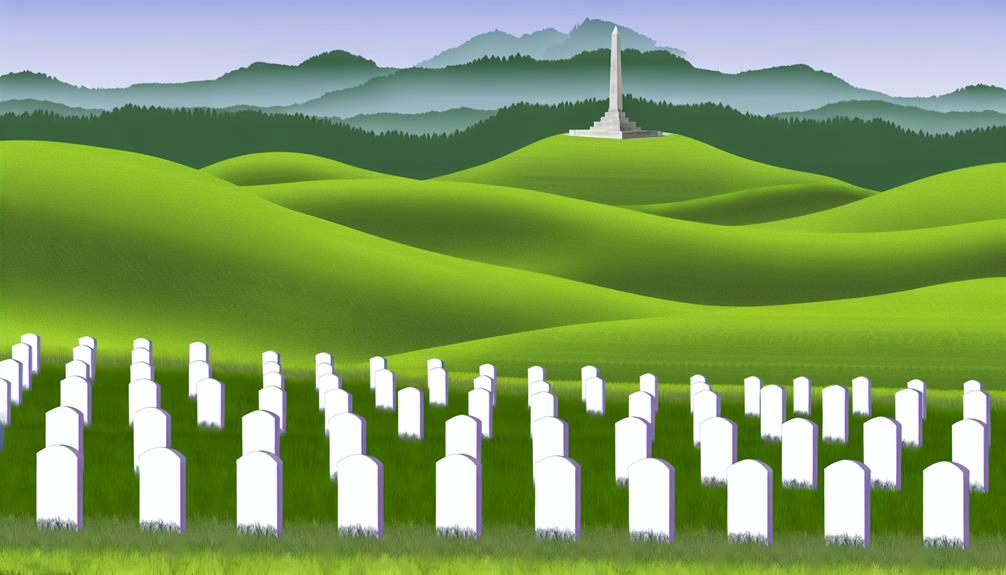The Valley of the Kings stands as a tribute to ancient Egypt's profound reverence for the afterlife and the divine rulers who governed in life and death. Beyond its famed historical significance lies a trove of mysteries waiting to be unraveled, offering a glimpse into the intricate tapestry of beliefs and rituals that shaped the civilization's view of eternity. As the sun sets over the majestic desert horizon, the shadows cast over this sacred valley whisper tales of forgotten pharaohs and untold secrets buried within the depths of time, beckoning further exploration into the enigmatic domain of the ancient Egyptian underworld.
Key Takeaways
- Valley of the Kings: Burial site for pharaohs and nobles.
- Discovery in 1922 by Howard Carter.
- Royal mummies and ancient artifacts found.
- Blend of artistry and engineering in tomb architecture.
- Reflects ancient Egyptian beliefs in the afterlife and societal hierarchy.
History of the Valley
Initially discovered by Howard Carter in 1922, the Valley of the Kings in Egypt holds a rich historical significance dating back to the New Kingdom period. This valley served as a burial ground for numerous pharaohs and powerful nobles from approximately the 16th to the 11th century BC. The tombs within the Valley of the Kings were adorned with intricate wall paintings, hieroglyphs, and contained treasures meant to accompany the deceased into the afterlife.
One of the most notable aspects of the Valley of the Kings is the discovery of royal mummies within several tombs. The mummies found in this valley have provided valuable insights into ancient Egyptian burial practices, religious beliefs, and even the physical characteristics of these rulers. The preservation of these royal mummies has allowed modern scholars to study them extensively, unraveling mysteries of the past.
Moreover, the Valley of the Kings has yielded a plethora of ancient artifacts, ranging from golden treasures to intricately carved statues. These artifacts offer a glimpse into the artistic and technological achievements of the ancient Egyptians. Each discovery within this valley adds to our understanding of this ancient civilization, shedding light on their customs, beliefs, and societal structures.
Tomb Architecture
The architectural design of the tombs within the Valley of the Kings in Egypt showcases a remarkable blend of artistic mastery and engineering ingenuity, reflecting the reverence and meticulous planning devoted to the burial sites of the pharaohs and nobles of the New Kingdom period. The tombs in the Valley of the Kings exhibit an evolution in architectural styles over time, with early tombs resembling simple pits or trenches, gradually advancing to more elaborate and intricate structures as seen in later tombs such as that of Tutankhamun.
Tomb symbolism played a significant role in the construction of these burial sites, with each tomb carefully designed to reflect the beliefs and values of ancient Egyptian society. The layout of the tombs, the decorations, and the inclusion of various passages and chambers all held symbolic significance related to the journey of the deceased into the afterlife.
Construction techniques employed in the creation of these tombs were sophisticated for their time, utilizing tools and methods that allowed for the excavation of deep burial chambers and the construction of elaborate passageways while maintaining structural integrity. The burial chambers themselves were often intricately decorated with scenes from Egyptian mythology and religious texts, emphasizing the importance of the pharaoh's passage to the world beyond.
Pharaohs' Burial Practices
Burial practices of the pharaohs in ancient Egypt were meticulously orchestrated rituals that encompassed religious beliefs, social status, and the quest for eternal life. These rituals were deeply intertwined with the ancient beliefs of the Egyptians, who viewed death not as the end but as a transformative phase to the afterlife. The pharaohs, considered divine rulers, were believed to be vital mediators between the mortal world and the gods, making their burial practices of utmost significance.
Central to the pharaohs' burial practices were religious ceremonies aimed at ensuring a successful journey to the afterlife. The elaborate tombs in the Valley of the Kings were not merely resting places but served as gateways to the eternal world where the pharaohs would continue their divine duties. The walls of these tombs were adorned with intricate paintings and hieroglyphs depicting scenes from Egyptian mythology, intended to guide the pharaoh on their voyage and assist them in overcoming the challenges of the afterlife.
Furthermore, the burial practices of the pharaohs also reflected the societal hierarchy and the pharaoh's status in Egyptian society. The grandeur and complexity of the tombs were often indicative of the pharaoh's power and wealth, showcasing their importance even in death. Overall, the pharaohs' burial practices were a statement to the ancient Egyptians' deep-rooted beliefs in the afterlife and their meticulous preparations to guarantee a prosperous eternal existence for their divine rulers.
Famous Discoveries
Exploring the extensive history of the Valley of the Kings in Egypt reveals a trove of famous discoveries that have shed light on the ancient practices and beliefs surrounding pharaonic burials. Among these discoveries, the unearthing of Tutankhamun's treasures stands out as one of the most significant. Howard Carter's discovery of King Tutankhamun's tomb in 1922 revealed a wealth of artifacts, including the iconic golden death mask, jewelry, chariots, and other treasures that provided invaluable insight into the opulence and craftsmanship of the New Kingdom.
Furthermore, the Valley of the Kings has been instrumental in unraveling the mysteries of the mummification process. The meticulous preservation of pharaohs' bodies through the mummification process was a central aspect of ancient Egyptian funerary practices. The discovery of well-preserved mummies, such as that of Ramses II, has allowed researchers to study the techniques and rituals associated with mummification, offering a glimpse into the religious beliefs and customs of the time.
These famous discoveries not only showcase the advanced craftsmanship and artistry of the ancient Egyptians but also provide a window into their complex burial rituals and beliefs. The Valley of the Kings continues to be a treasure trove of archaeological wonders, offering invaluable insights into the rich history and culture of ancient Egypt.
Howard Carter's Legacy
Howard Carter's enduring legacy in the field of Egyptology is marked by his groundbreaking discovery of King Tutankhamun's tomb in 1922, a find that continues to captivate scholars and enthusiasts alike with its remarkable insights into ancient Egyptian history and culture. Carter's archaeological impact is profound, as the discovery of the tomb provided unprecedented access to a wealth of artifacts and treasures that had remained undisturbed for over 3,000 years. The meticulous documentation and preservation of these findings not only expanded the understanding of Tutankhamun's reign but also shed light on various aspects of daily life, religious practices, and burial customs in ancient Egypt.
Beyond the sheer archaeological significance, Howard Carter's legacy extends to the cultural sphere. The unearthing of King Tutankhamun's tomb sparked global fascination with ancient Egypt, leading to a surge in Egyptological studies and public interest in the field. The exquisite craftsmanship and symbolic meanings behind the artifacts found in the tomb highlighted the artistic prowess and spiritual beliefs of the ancient Egyptians, fostering a deeper appreciation for their rich cultural heritage.
Conservation Efforts
Marked by a vital commitment to preserving and safeguarding the invaluable archaeological treasures unearthed in the Valley of the Kings, Egypt's conservation efforts stand as a proof of the enduring legacy of ancient civilizations. The Valley of the Kings, renowned for its historical significance and rich archaeological heritage, requires meticulous care and conservation strategies to guarantee the preservation of its treasures for future generations.
Archaeological techniques play an essential role in the conservation efforts within the Valley of the Kings. Through the use of advanced scientific methods such as ground-penetrating radar and 3D scanning, experts can uncover hidden chambers and artifacts without causing damage to the fragile structures. Preservation methods, including controlled humidity environments and strategic structural reinforcement, are employed to prevent deterioration of the ancient tombs and monuments.
The cultural significance of the Valley of the Kings underscores the importance of conservation efforts. Beyond the scientific value of the archaeological finds, these treasures hold immense cultural and historical importance for Egypt and the world. Community involvement is also key in the conservation process, as raising awareness and garnering support from local residents and stakeholders ensures a collective effort in protecting this UNESCO World Heritage Site.
Visitor Experience
Improving the visitor experience at the Valley of the Kings involves a holistic approach that integrates historical context with modern amenities to provide a profound and educational journey through this ancient site. Interactive exhibits and immersive tours play an essential role in engaging visitors and making their exploration of the Valley of the Kings truly memorable. By combining these elements, visitors can gain a deeper understanding of the historical significance of the site and the lives of the pharaohs buried there.
To enhance the overall experience, the Valley of the Kings offers a variety of interactive exhibits that bring the history and archaeology of the site to life. These exhibits allow visitors to interact with replicas of artifacts found in the tombs, providing a hands-on learning experience that appeals to both adults and children. Additionally, immersive tours led by knowledgeable guides offer visitors the opportunity to explore the mysteries of the ancient Egyptian civilization while exploring the intricate passageways and chambers of the tombs.
The table below highlights some of the key elements that contribute to the immersive visitor experience at the Valley of the Kings:
| Aspect | Description | Benefits |
|---|---|---|
| Interactive Exhibits | Replicas of artifacts for hands-on exploration | Enhances learning experience and engagement |
| Knowledgeable Guides | Expert-led tours providing historical insights | Offers in-depth understanding of the site |
| Modern Amenities | Facilities like visitor centers and rest areas | Ensures visitor comfort and convenience |
Symbolism in Artifacts
The investigation of artifacts found within the tombs of the Valley of the Kings reveals a rich tapestry of symbolism deeply ingrained in ancient Egyptian culture and beliefs. These artifacts hold immense cultural significance, shedding light on the ancient beliefs and practices of the Egyptians. Through intricate designs and hieroglyphics, the artifacts serve as a window into the artistic expression and religious rituals of this civilization.
Various symbols found on the artifacts depict elements that were vital to the ancient Egyptians, such as the scarab beetle representing rebirth and regeneration, and the ankh symbolizing life and immortality. These symbols were not merely decorative but held profound meanings that were central to their religious beliefs and practices. For example, the presence of the Eye of Horus symbolized protection, royal power, and good health.
Moreover, the careful placement of these symbols within the artifacts suggests a deliberate intention to guide the deceased through the afterlife, showcasing the intricate connection between art, religion, and the rituals associated with death in ancient Egypt. The artifacts found in the Valley of the Kings provide valuable insights into a civilization that revered symbolism as a means of conveying profound truths about existence and the afterlife.
Modern Research Insights
Recent scholarly investigations have exposed compelling insights into the ancient artifacts discovered in the Valley of the Kings, illuminating new light on the cultural practices and religious beliefs of ancient Egyptian civilization. Through the application of advanced scientific advances and innovative archaeological techniques, researchers have been able to explore deeper into understanding the significance of the artifacts found in this renowned burial site.
One key aspect that modern research has shed light on is the meticulous craftsmanship and attention to detail present in the artifacts. By utilizing cutting-edge technology such as high-resolution imaging and chemical analysis, scientists have been able to uncover hidden inscriptions and intricate designs that were previously unnoticed. These findings have provided valuable information about the materials used, the techniques employed, and the symbolic meanings embedded within the artifacts.
Furthermore, modern research has revealed new insights into the religious practices of the ancient Egyptians. By studying the placement of artifacts within the tombs and analyzing the accompanying texts and images, scholars have gained a deeper understanding of the rituals and beliefs associated with the burial process. This has allowed for a more thorough interpretation of how religion influenced every aspect of ancient Egyptian life, including death and the afterlife.
Frequently Asked Questions
Are There Any Hidden Chambers yet to Be Discovered in the Valley of the Kings?
Exploration techniques, such as ground-penetrating radar technology, have been instrumental in uncovering hidden chambers in various archaeological sites. The application of radar technology allows researchers to non-invasively scan the ground, revealing anomalies that could indicate the presence of undiscovered structures.
In the context of the Valley of the Kings, the use of such advanced methods holds promise for potentially revealing hidden chambers that may still lie undiscovered beneath the desert sands.
How Do Archaeologists Ensure the Preservation of Delicate Artifacts in the Tombs?
Archaeologists guarantee artifact preservation through a variety of conservation techniques. These methods include controlled environmental conditions, such as humidity and temperature regulation, to prevent deterioration.
Additionally, experts employ careful handling procedures, use specialized materials for storage, and implement monitoring systems to track any changes in the artifacts over time.
What Tools and Technologies Are Used in the Ongoing Research at the Site?
In ongoing archaeological research, tools such as remote sensing and ground-penetrating radar play vital roles in uncovering buried structures and artifacts.
Remote sensing enables the non-invasive exploration of subsurface features through aerial imagery and satellite data analysis.
Ground-penetrating radar, on the other hand, uses electromagnetic radiation to detect objects and features buried beneath the ground.
These technologies aid researchers in mapping and understanding ancient sites without disturbing the physical integrity of the site.
Is There a Specific Reason Behind the Placement of Each Pharaoh's Tomb in the Valley?
In the intricate tapestry of ancient burial practices, the reasoning behind tomb placement for each pharaoh reveals a profound narrative.
Delving into the nuances of ritual, power dynamics, and celestial alignment, the location of a pharaoh's final resting place signifies more than mere spatial arrangement—it symbolizes a cosmic orchestration of beliefs and heritage.
The deliberate positioning of each tomb echoes a timeless legacy woven with spiritual significance and earthly power.
What Challenges Do Experts Face in Deciphering the Hieroglyphics Found in the Tombs?
Deciphering hieroglyphics poses numerous challenges to experts due to the complex nature of the ancient script and the myriad of potential meanings each symbol can represent. Translation difficulties arise from the lack of context, evolving linguistic conventions, and the vast time gap between modern researchers and the original creators of the inscriptions.
Additionally, variations in grammar, symbolic meaning, and the potential for errors in transcription further complicate the process of accurately interpreting hieroglyphic texts.
Conclusion
To sum up, the Valley of the Kings in Egypt stands as a testament to ancient Egyptian beliefs and practices surrounding death and the afterlife.
With over 60 tombs discovered to date, the intricate tomb architecture and elaborate burial practices showcase the reverence and importance placed on ensuring a prosperous eternal existence for pharaohs and nobles.
This archaeological site continues to captivate researchers and visitors alike, offering invaluable insights into the ancient Egyptian civilization.


